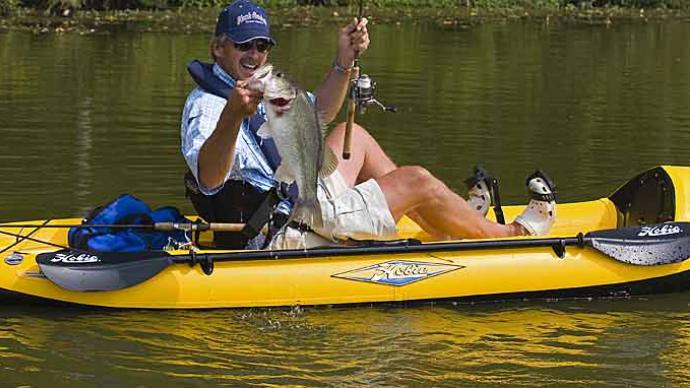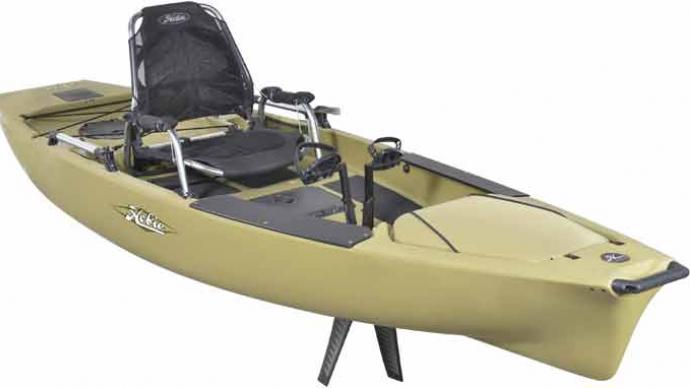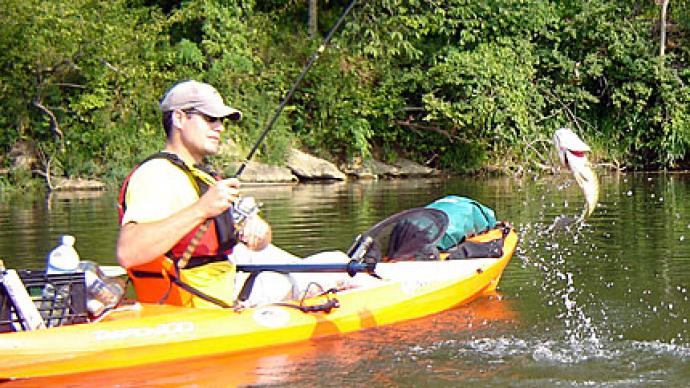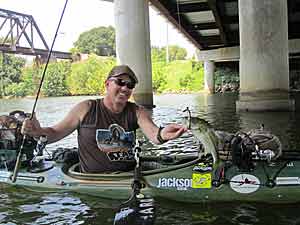
Anglers, their sunglasses perched above their hat brims, milled around the parking lot. They were in groups of three or four. Some leaned against vehicles and scuffed their shoes across the pavement. Others sat in the shade of tall pine trees. After eight hours of casting under bluebird skies and warm spring sunshine, many devoured snacks and chugged cold drinks. They all took turns asking about the other anglers’ days and responding with their tales of bass caught and lost. Laughter comes after most of the stories. The scene looks no different than any weekend bass tournament, but that was about to change. One by one, they brought their catch to the tournament director. Instead of dripping bags filled with five-bass limits, these anglers presented smartphones and digital cameras.
Most of the anglers at this weigh-in are members of the Hardcore Kayak Fishing Team, a tournament club that calls Charlotte, N.C., home and the lakes along the Catawba River – Wylie, Mountain Island, and Norman in particular – their playing fields. The rest are guests from other clubs, some traveling a couple of hours from Greensboro, N.C., who take their turn on reciprocal invitations to tournaments. They met at Hunt Fish Paddle, a tackle shop and kayak dealer in Lake Wylie, S.C., on this particular March day, when it was colder and darker. Each drew a playing card from a standard deck, the tournament director noting which one. During the day, they photographed each bass stretched out on a measuring board next to their playing card, identifying the bass as being caught in this tournament. At the weigh-in, the tournament director reviewed each picture, double-checking the measurement and jotting down each angler’s biggest bass, up to five. The winner has the most inches, and the totals sort the field. It took four bass that measured a combined 57.5 inches on this day to win. The big fish for the day was 17.25 inches.
When someone mentions bass tournaments, thoughts turn to 20-foot fiberglass boats with 250-horsepower outboards slicing small wakes across quiet coves in dawn’s early light. But the truth is many tournament anglers compete in smaller fiberglass, aluminum, and even inflatable belly boats. Joining their ranks is a growing contingent of anglers who paddle kayaks. The narrow boats date back about 4,000 years when native people living along the Bering Sea and the Arctic and northern Pacific and Atlantic oceans hunted from ones framed with whalebones and covered with animal skins. In the 1950s, inflatable and fiberglass kayaks were introduced. Manufacturers switched to the molded plastic versions popular today in the 1970s. And they’re getting more popular each year.
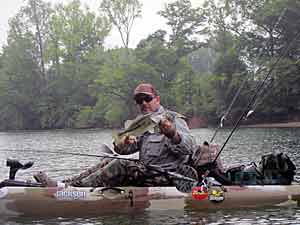
The Boulder, Colo.-based trade group, Outdoor Industry Association, estimated that 7.8 million Americans – 2.8% of the population – paddled a kayak in 2008. That was up from 1.6% in 2006. Some of that increase can be credited to me and my wife, who first dipped a paddle on a guided tour of Roanoke Sound on North Carolina’s Outer Banks. We were surprised at how easy kayaking is, from getting into one without getting wet and paddling a reasonable distance while navigating a headwind. We found the kayak stable – much more than a canoe – and easily maneuverable with some paddle coordination. They also are relatively inexpensive and easy to transport – most hitch rides to the water on top of cars or, as some of the Hardcore anglers do, in the bed of a pickup truck. And maybe best of all, they don’t use any two-cycle oil, gas, or ethanol treatment. They’re an excellent option for people of any age to get out on the water. “We got guides,” said club president Tim Stewart of the Hardcore membership mix. “We have 15-year veterans, and we have people just starting.” The club formed about 15 years ago when seeing someone casting from a kayak – and often a kayak itself – was odd. Now they are everywhere. Just a few miles north of this tournament weigh-in is the U.S. National Whitewater Center, where U.S. Olympians practice on man-made rapids. Visitors can rent kayaks to paddle the Catawba River, Lake Wylie’s main tributary.
This Hardcore tournament was a multiple launch event. After the competitors checked in, they could travel to any launch ramp on the lake but needed to be back by 3 p.m. Besides the boats and how the bass are scored, there are a few other differences from traditional powerboat tournaments. Trolling is allowed in kayak events, but this club limits the number of rods dragging baits to two. Umbrella rigs are OK, too. Most kayak tournaments are eight hours long. And some leave from a single ramp. Stewart said the range for kayak anglers is about 3 miles, depending on weather conditions and how much paddling they want to do.
There are different kayaks, including two-seat models and single-seat ones used in tournaments. Those can be separated into two groups. The first consists of the sit-in kayaks – SITs. They resemble the original kayaks, where the hull comes up around the paddler, and are often used in saltwater and whitewater. They are usually faster but less stable than the other style, sit-on-top kayaks. Sporting a wider beam, SOTs are stable enough for an angler to stand in. They are the most popular option among tournament anglers. “I’d bet 90 percent of kayak fishermen are in a SOT,” Stewart said.
Regardless of the style, a lot of time is put into rigging rides. Anglers don’t stop the do-it-yourself customization at a few rod holders. It runs from decal decorations to electronics that would rival the most plugged-in powerboat. Run with a small 12-volt battery, the kind used to power the toy cars children motor around driveways; kayak anglers use graphs, scans, and GPS to find bass. Most tournament kayaks are 12- to 14 feet long, each angler selecting a size after debating their speed and stability requirements. Inside, anglers can carry five or more rods and enough tackle to stock a small store. But they need to consider what they pull from the stash because some presentations work a little differently from a kayak. A Colorado-bladed spinnerbait, for example, has enough resistance on the retrieve to pull a kayak around. “Even a 2-pound bass will tow you around,” Stewart said. One angler in this tournament shared a photo at the weigh-in of a giant catfish that spun his kayak 180 degrees.
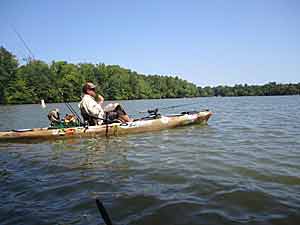
Stewart said kayaks shine in water bigger boats can’t reach: “You can paddle them under trees or over them to access water other boats can’t – or launch them where others can’t.” Kayaks are stealthy, too, giving anglers the upper hand in spooky bass conditions such as clear or super-shallow water. But getting to the fish is only one of their benefits. “As far as a specific technique, I’d say trolling would be one because you are always going trolling speed,” he quipped. Many kayak anglers keep a trolling lure handy, which they drag when moving between spots to avoid wasting fishing time. Kayaks also provide a great perspective on the dock fishing. Many powerboat anglers must kneel or lean over to get low enough to skip lures far under docks, where the unmolested and biggest bass always seem to be. Kayak anglers are already down there. “Once you get used to it, it’s super easy to fire one parallel to the water and way back in there,” he said. “Sometimes I go behind and under the dock walkways, which a bass boat can’t do. ‘Yaks’ are great for going over thick grass and lily pads to use a punch bait. That’s stuff you wouldn’t get a trolling motor through.”
Tournament fishing is only a portion of what Hardcore is all about. Like powerboat clubs, its members schedule fun events, too, including dedicating a day to chasing panfish. Members donate their catch to the Carolina Raptor Center in Huntersville, N.C., to feed the birds of prey recuperating there. The club also holds a big tournament in the fall that’s limited to 53 kayaks – the number of playing cards in a deck. The members put their spin on it, like their kayaks, each year welcoming back a longtime supporter, who starts the morning by playing “The Star-Spangled Banner” on his electric guitar lakeside. But they aren’t the only ones who like to put on a big kayak bass tournament.
Adam Fillmore is hosting Kayaks and Greenbacks, a two-day Lake Wylie tournament slated for the end of March. He’s also the owner of Hunt Fish Paddle, where Hardcore held its weigh-in. “I got into it by accident,” he said of kayak fishing. It happened during a trip to the beach, where there was no bank or pier to fish from. So he borrowed a kayak from a friend. Its stability surprised him. “Now I stand up in one and pitch jigs.” Anglers will be aiming at a big prize in his tournament, which boasts a $30,000 payout, with $10,000 going to the winner with a full 200-kayak field. About a month ahead, he had almost 75% of it filled. Participants came from Tennessee, Texas, Florida, and Pennsylvania. Each paid a $150 entry fee.
Back at the weigh-in, all the pictures have been checked, and the payout, built from $25 entry fees, has been distributed to the top-finishing anglers. The stories continue as tackle is broken down and kayaks secured for their rides home. Questions about the next tournament, where some are going for a meal, and a few cold ones fly about. They’re directed to “Capt. Ron” or “The Enforcer” or “Young Blood.” Stewart – or “Stew Rat” – said nicknames are essential to the camaraderie that keeps the club fun. “Very few are picked. They are generally bestowed by someone else for a reason,” he said. “We require that you supply one with your sign-up for our annual tourney in October. It’s just part of the fun. It stems from the fact that most communication was on fishing forums in the early days, and many people were known by their screen names more than their real ones.” But times are changing and, to some degree, so is the club as it brings in new members and interacts with other clubs in the Carolinas. Those who cast for cash from kayaks have come together in small groups but not a national one, like B.A.S.S. chapters have B.A.S.S., which holds televised tournaments with lots of cash. At least not yet. But if that day comes, he doesn’t think it will affect Hardcore. “We’ll be here, doing our thing.”


